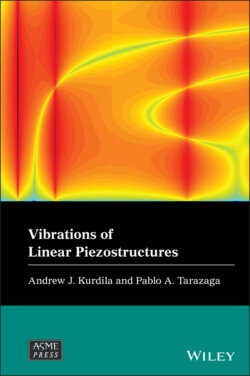Читать книгу Vibrations of Linear Piezostructures - Andrew J. Kurdila - Страница 15
1.1.2 One Dimensional Direct and Converse Piezoelectric Effect
ОглавлениеIn view of these observations, at a fundamental level, the micromechanics of piezoelectricity is understood in terms of crystalline asymmetry. While the most general theory of linear piezoelectricity of material continua in three dimensions is discussed in Chapter 5, intuition can be built by considering a one dimensional example. Figure 1.5 depicts the direct piezoelectric effect graphically, while the converse effect is shown in Figure 1.6. For the specimens shown, the mechanical variables are the stress and strain , and the electrical variables include the electric field , electric displacement , voltage , and the electrical potential . In Figure 1.5 we suppose that the top and bottom of the specimen are free to displace. A thin film electrode, one that does not alter the mechanical properties of the specimen, is applied to the top and bottom surfaces by a deposition or sputtering process. An ideal current meter, over which the potential difference is approximately zero, is attached to the top and bottom electroded surfaces. A positive stress is applied as shown. As we discuss in Chapter 5 the constitutive laws that couple the electrical and mechanical variables can take many forms. In this one dimensional example we choose to express the dependency among the electrical and mechanical variables as
(1.1)
where is the mechanical compliance constant, is the piezoelectric coupling constant, and is the permittivity constant. See Chapter 5 for a precise definition of these constants when interpreted as elements of tensors suitable for piezoelectric continua in three dimensions. Since the current meter is ideal, the electrical potential at the top electrode is equal to the potential at the bottom electrode, and the electric field . From Equation 1.1 it follows that the strain is positive, and the top and bottoms of the specimens displace by approximately , and the specimen stretches by a total amount . The magnitude of the charge on the electrodes can be obtained from the boundary conditions . Thus, we see that either the application of a positive stress , or equivalently of a positive strain , induces charges having magnitude on the faces of the specimen.
In contrast, Figure 1.6 illustrates how the application of an electric potential across a piezoelectric specimen generates a deformation. In this case, we assume that the potential at the top electrode is , the potential at the lower electrode is , and the voltage source has a voltage . Since the stress and , the electrical field is approximately given by , and the strain in the specimen at its top and bottom is . In this case, the specimen compresses in total approximately by .
Figure 1.5 The direct piezoelectric effect.
Figure 1.6 The converse piezoelectric effect.
